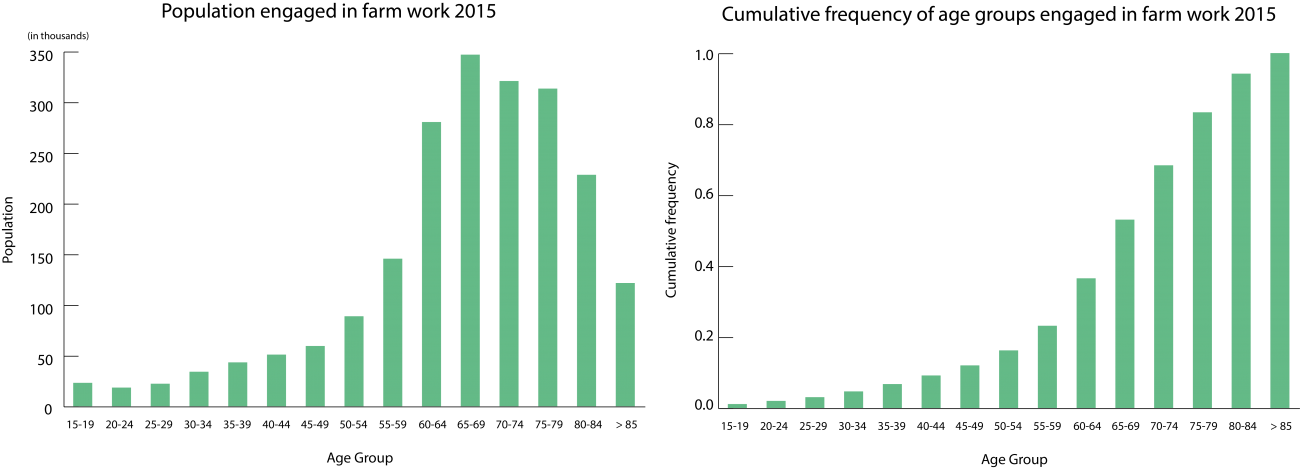New developments in Smart Agriculture
The agricultural sector in Japan is facing acute labour shortages, which are anticipated to get worse in the coming years. Furthermore, the age group involved in farming is prevalently over 65 years old - with 60% of farmers older than 65 - and farmers are having troubles to find successors for their farms. In addition, the demand for Japanese agricultural products abroad is steadily rising, and Japan is starting to struggle to meet it and supply its own domestic market.
The Japanese Central Government, academia and the private sector are facing these challenges head on and have invested in technology to resolve these problems. In particular, the government has taken initiatives - so-called Strategic Innovation Promotion Programs (SIP) - to foster innovation with applied, cross-disciplinary funding policies. It has also invested into infrastructure that will enable new technologies. Academia and the private industry have recognised that state-of-the-art technologies like AI, IoT, ICT and self-driving robots can be used to solve practical problems in agriculture and have invested in it. This has opened a new promising market that was predicted to grow rapidly in the next five to six years. The Japanese Smart Agriculture market is expected to be valued at approximately ¥33 billion by 2023.

Situation and Challenges
Japan’s economy is facing a serious demographic challenge with a decreasing and rapidly aging population. In a report recently published by the National Institute of Population and Social Security Research, Japan’s population is predicted to fall 6.3% by 2030 and 16.3% by 2045 compared to 2015 - Tokyo being the only exception to this trend (1). The labour force will not only decrease because of the shrinking population but also because the population, on average, is rapidly getting older. These two effects will reduce the working-age group (15-64) by 37.7% on average by 2045. However, rural communities and smaller prefectures are likely to be more affected, with Akita prefecture, located at the northern tip of Japan’s main island, projected to see a 65.1% drop in its labour force by 2045 (1). This general trend is already heavily affecting the agriculture sector today.
The population engaged in farm work - roughly 2 million people in 2015 - represents only 1.65% of the Japanese population (2) (3). According to the 2015 census by the Ministry of Agriculture, Forestry and Fisheries, less than 10% of the labour force mainly engaged in farm work is below the age of 45. Alarmingly, more than 60% of farmers is above the age of 65 (2) (see Figure 1), compared to 26.6% in the whole population (1). This lack of young workers is not expected to disappear in the foreseeable future, as the agricultural sector has been steadily losing in popularity these past few decades.
The decreasing population threatens the agricultural sector on a fundamental level as it inherently entails a shrinking domestic market for agricultural products. Some financial analysts see ranking up exports as a solution, given that the demand for Japanese products is increasing abroad - 2017 saw a 7.6% increase to ¥807.6 billion (4).
These two concurrent trends - decreasing work force and increasing demand - show that to remain competitive on the market, Japan’s agriculture, which momentarily does not rely on immigration for workforce, has to be less dependent on manual labour and rely on technology to solve its structural difficulties.

In this broader context, Smart Agriculture, a market totalling ¥10’420 million (95 million USD) in fiscal year (FY) 2016, is projected to see a 300% expansion until FY2023 to an estimated ¥33’339 million (305 million USD) (see Figure 2) (5). Smart Agriculture is a relatively young market, relying on upcoming technologies, mainly information and communication technology including big data and IoT and robotics to increase agricultural production, reduce costs, facilitate sales and provide a safer work environment for labourers. It comprises the cultivation support sector, which, amongst others, produces solutions for cloud farming and compound environmental control, helping farmers to regulate the artificial climate of greenhouses. Sales support solutions connect producers with buyers through ICT. Operational support solutions reduce the workload for administrative tasks and help to predict harvest yield and time by relying on past data and weather forecasts. Precision farming exploits state-of-the-art technologies to develop unmanned farm machines and autopilot to reduce the time required for highly repetitive and automatable processes. Finally, agricultural robots are being developed for everything from assistive exo-skeletons to harvesting robots.

